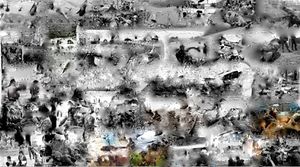Unintended Images: Difference between revisions
No edit summary |
No edit summary |
||
| Line 5: | Line 5: | ||
|Thumbnail=Screen Shot 2014-10-26 at 16.10.08.jpg | |Thumbnail=Screen Shot 2014-10-26 at 16.10.08.jpg | ||
|Website=www.artyomkocharyan.com | |Website=www.artyomkocharyan.com | ||
|Description=Artyom’s work entitled | |Description=Artyom’s work entitled “Related Images” is a series of digital paintings that are based on search results of Google Images. In his work Artyom examines the dynamics of current image culture, namely their proliferation within the online world. | ||
As a result of proliferation the online world become a space where images appear to their viewer within multiplicity, Google image search is such an example. By gathering multiple images within one page Google creates a new ‘large image’ that is constructed form multiple ones. Without it being its primary concern. Understandably so, Google disregards the aesthetical form of the ‘large image’ since it positions individual images according to their relevance rather then their visual content. | |||
As a result, this ‘large images’ appear as ‘broken’ and fragmented, and have no coherence to be read as a single image. | |||
Artyom’s work reflects on the incoherence that comes with the multiplicity of images. He uses screenshots of different Google search result, which he manipulates within Photoshop by using a ‘healing’ or a ‘patching’ tool. For his series Artyom drew inspiration from several paintings, particularly those of Pieter Bruegel the Elder, which regardless of their overcrowded and noisy aesthetics managed to remain their wholeness as an image. Those paintings took into account the gaze of the viewer, providing pathways through which the human eye could travel the image. Similar Artyom’s work attempts to rehabilitate those ‘broken’ images and reintroduce a coherence that would allow them to be read as a whole. | |||
}} | |||
Revision as of 12:40, 21 May 2015
| Unintended Images | |
|---|---|
| Creator | Artyom |
| Year | 2015 |
| Bio | Artyom Kocharyan (AM) is visual artist based in Rotterdam. His work explores the contemporary visual culture, namely the culture of images that increasingly dominate the world of communication. Artyom’s work is concerned with the representation aspect of images and their ability to determine our vision of the world. Artyom is engaged with the representation apparatus that is peculiar to current digital and online culture. |
| Thumbnail | |
| Website | www.artyomkocharyan.com |
Artyom’s work entitled “Related Images” is a series of digital paintings that are based on search results of Google Images. In his work Artyom examines the dynamics of current image culture, namely their proliferation within the online world.
As a result of proliferation the online world become a space where images appear to their viewer within multiplicity, Google image search is such an example. By gathering multiple images within one page Google creates a new ‘large image’ that is constructed form multiple ones. Without it being its primary concern. Understandably so, Google disregards the aesthetical form of the ‘large image’ since it positions individual images according to their relevance rather then their visual content. As a result, this ‘large images’ appear as ‘broken’ and fragmented, and have no coherence to be read as a single image.
Artyom’s work reflects on the incoherence that comes with the multiplicity of images. He uses screenshots of different Google search result, which he manipulates within Photoshop by using a ‘healing’ or a ‘patching’ tool. For his series Artyom drew inspiration from several paintings, particularly those of Pieter Bruegel the Elder, which regardless of their overcrowded and noisy aesthetics managed to remain their wholeness as an image. Those paintings took into account the gaze of the viewer, providing pathways through which the human eye could travel the image. Similar Artyom’s work attempts to rehabilitate those ‘broken’ images and reintroduce a coherence that would allow them to be read as a whole.

